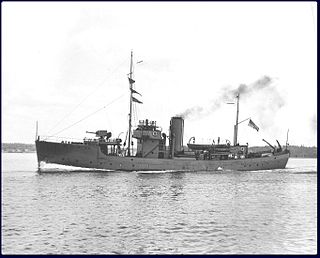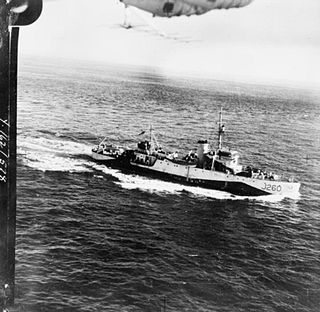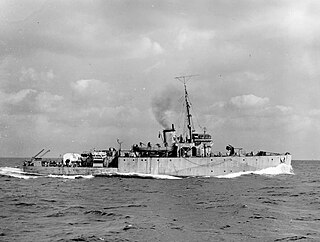
HMCS Nootka was a Fundy-class minesweeper that served in the Royal Canadian Navy from 1938–1945. She saw service during the Second World War as a local minesweeper working out of Halifax, Nova Scotia. She was named for Nootka Sound. In 1943 she was renamed HMCS Nanoose to allow the unit name Nootka to be used by the destroyer HMCS Nootka. Following the war the ship was sold for mercantile use, becoming the tugboat Sung Ling. The ship's registry was deleted in 1993.
HMCS Miramichi was a Bangor-class minesweeper that served in the Royal Canadian Navy during the Second World War. She remained on the west coast of Canada for the entirety of the war. She was named for Miramichi, New Brunswick. After the war she was purchased with the intent of conversion for mercantile use. However, that never took place and instead, she was scrapped in 1949.

HMCS Sarnia was a Bangor-class minesweeper that served in the Royal Canadian Navy during the Second World War. She saw action in the Battle of the Atlantic and the Battle of the St. Lawrence. She was named for Sarnia, Ontario. After the war she was refitted and transferred to the Turkish Naval Forces and renamed Büyükdere. She served with them until 1972.
HMCS Kentville was a Bangor-class minesweeper that served in the Royal Canadian Navy during the Second World War. She saw action in the Battle of the Atlantic. She was named for Kentville, Nova Scotia. After the war she was recommissioned for a short period with the Royal Canadian Navy before being sold to Turkey in 1957 and renamed Bartin. She served with the Turkish Naval Forces until 1972.
HMCS Courtenay was a Bangor-class minesweeper constructed for the Royal Canadian Navy during the Second World War. Entering service in 1942, Courtenay spent the entire war on the West Coast of Canada. The vessel was decommissioned in 1945 and sold for mercantile service in 1946. The fate of the vessel is uncertain.

HMCS Goderich was a Bangor-class minesweeper constructed for the Royal Canadian Navy during the Second World War. Entering service in 1941, Goderich spent the entire war as a local convoy escort based out of Halifax, Nova Scotia. The vessel was decommissioned in 1945 and placed in reserve. Reacquired during the Korean War, the vessel was modernized but never re-entered service and was sold for scrap and broken up in 1959.
HMCS Grandmère was a Bangor-class minesweeper constructed for the Royal Canadian Navy during the Second World War. Entering service in 1941, the minesweeper took part in the Battle of the Atlantic and the Battle of the St. Lawrence before being taken out of service in 1945. The ship was sold for mercantile service following the war, first as the yacht Elda and then the cargo ship Jacks Bay. The ship was sold for scrap in 1968.
HMCS Bellechasse was a Bangor-class minesweeper constructed for the Royal Canadian Navy during the Second World War. The minesweeper entered service in 1941 and spent the entire war on the West Coast of Canada. Sold in 1946 for mercantile conversion, the conversion was not carried out and Bellechasse was broken up for scrap instead.
HMCS Malpeque was a Bangor-class minesweeper constructed for the Royal Canadian Navy during the Second World War. Entering service in 1941, the minesweeper took part in the Battle of the Atlantic and the invasion of Normandy. Malpeque was decommissioned in 1945 and placed in reserve. The vessel was reacquired during the Korean War, however the ship never re-entered service and was sold for scrap in 1959.
HMCS Outarde was a Bangor-class minesweeper constructed for the Royal Canadian Navy during the Second World War. Entering service in 1941, the ship spent the entire war on the West Coast of Canada. Following the end of the war, the vessel was sold in 1946 for mercantile conversion and renamed Psing Hsin. In 1950 the vessel was sold again and renamed Content and remained in service until broken up for scrap in 1951.
HMCS Quatsino was a Bangor-class minesweeper constructed for the Royal Canadian Navy during the Second World War. Entering service in 1941, the minesweeper spent the entire war on the West Coast of Canada. Following the war, the vessel was sold for mercantile conversion in 1947 and renamed Chen Hsin. In 1950 the merchant ship was sold and renamed Concord before being broken up for scrap in 1951.

HMCS Wasaga was a Bangor-class minesweeper constructed for the Royal Canadian Navy during the Second World War. Entering service in 1941, the minesweeper took part in the Battle of the Atlantic and the invasion of Normandy. Following the end of the war, the vessel was sold in 1946 and broken up for scrap in 1947.
HMCS Bayfield was a Bangor-class minesweeper initially constructed for the Royal Navy during the Second World War. Transferred to the Royal Canadian Navy in 1942, the minesweeper saw service on both the West and East Coasts of Canada as a convoy escort and patrol vessel. In 1944, Bayfield sailed for European waters and took part in the invasion of Normandy. She remained in European waters for the rest of the war and was returned to the United Kingdom in September 1945. The minesweeper was laid up until being discarded for scrap in 1948.
HMCS Canso was a Bangor-class minesweeper initially constructed for the Royal Navy during the Second World War. Transferred to the Royal Canadian Navy in 1942, the minesweeper saw service on both the West and East Coasts of Canada as a convoy escort and patrol vessel. The vessel participated in the invasion of Normandy and spent the final years of the war in European waters. Canso was returned to the Royal Navy following the war and was broken up for scrap in 1948.

HMCS Caraquet was a Bangor-class minesweeper initially constructed for the Royal Navy during the Second World War. Transferred to the Royal Canadian Navy in 1942, the vessel served on both coasts of Canada and took part in the Battle of the Atlantic as a convoy escort and the invasion of Normandy. Following the war, the minesweeper was returned to the United Kingdom who then sold the ship to the Portuguese Navy in 1946. Renamed Almirante Lacerda, the vessel was used as a survey ship until 1975 when it was discarded.
HMCS Ingonish was a Bangor-class minesweeper initially constructed for the Royal Navy during the Second World War. Loaned to the Royal Canadian Navy in 1942, the vessel served on both coasts of Canada as a convoy escort and patrol vessel. Following the war, the minesweeper was returned to the Royal Navy and laid up. Ingonish was discarded in 1948.
HMCS Lockeport was a Bangor-class minesweeper initially constructed for the Royal Navy during the Second World War. Loaned to the Royal Canadian Navy in 1942, the minesweeper saw service on both coasts of Canada as a patrol vessel and convoy escort. Returned to the Royal Navy in 1945, Lockeport was discarded in 1948.
HMCS Kelowna was a Bangor-class minesweeper constructed for the Royal Canadian Navy during the Second World War. Entering service in 1942, the minesweeper spent the entire war on the West Coast of Canada, mainly as a patrol vessel. Following the war, Kelowna was sold for mercantile conversion. Renamed Hung Hsin and Condor, the final disposition of the vessel is disputed.
HMCS Swift Current was a Bangor-class minesweeper that served with the Royal Canadian Navy during the Second World War. Entering service in 1941, the warship used as a training ship and convoy escort and took part in the battles of the St. Lawrence and the Atlantic. Following the war the ship was laid up until reacquired during the Korean War. Never re-entering service with Canada, Swift Current was sold to the Turkish Navy in 1958. Renamed Bozcaada, the minesweeper was discarded in 1971.

HMCS Blairmore was a Bangor-class minesweeper that served with the Royal Canadian Navy during the Second World War. Entering service in 1942, the ship took part in the Battle of the Atlantic and the invasion of Normandy. Following the war, the ship was laid up until 1958 when the Blairmore was transferred to the Turkish Navy. Renamed Beycoz, the vessel was discarded in 1971.






